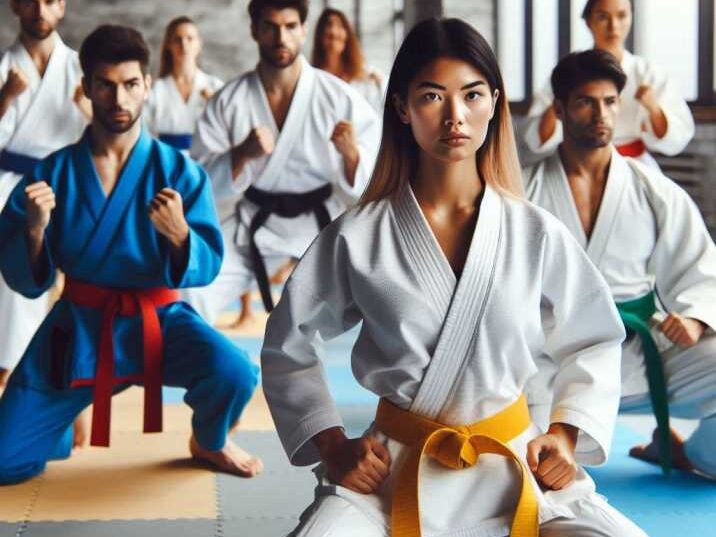Introduction
Table of Contents
Martial arts are about more than just self-defense. They teach us discipline, respect, and focus. But how do students of martial arts show their progress? One way is through belt levels or rankings, representing different skill stages. Each martial art has its way of measuring progress, but they all share a common goal: helping students become better versions of themselves. This article will explore the various levels of martial arts, how they work, and what it takes to advance. By the end, you’ll understand how training helps in the dojo, school, and life.

The Basics of Martial Arts Levels
What Are Martial Arts Levels?
In martial arts, levels represent your skill, knowledge, and dedication to your practice. These levels are marked by different belts or ranks, which signify how much you’ve learned and how proficient you are. The belt system is one of the most common ways to measure progress in martial arts.
The Belt System: What Do the Colors Mean?
The belt colors represent different stages of learning. Here’s a general idea of what each color stands for in many martial arts:
White Belt:
The white belt symbolizes a new beginning, representing the student’s first step into martial arts. It marks the start of learning fundamental techniques and the basics of self-discipline. At this stage, students focus on understanding the principles of martial arts and building a solid foundation.
Yellow Belt:
As students earn the yellow belt, they demonstrate a basic understanding of techniques and concepts. This stage signifies the absorption of core skills, where the learner begins to grasp the discipline’s essential movements and forms, setting the stage for further development.
Green Belt:
The green belt indicates that the student has reached an intermediate level, showing considerable progress in both technique and understanding. At this point, students refine their skills, becoming more comfortable and confident with their movements, while continuing to build strength and control.
Blue Belt:
At the blue belt level, students are considered advanced beginners. They have refined many basic skills and are learning more complex techniques. This stage reflects growing confidence and the ability to execute moves with greater precision and fluidity.
Brown Belt:
The brown belt is awarded to students nearing expertise. It signifies a deep understanding of the martial art’s techniques and principles. At this level, students are fine-tuning their abilities, preparing for the final challenges before reaching mastery.
Black Belt:
The black belt is the symbol of mastery over the basic techniques and signifies the completion of a long journey. While earning a black belt is a major achievement, it is not the end. Instead, it marks the beginning of a deeper, lifelong learning process in martial arts.

Not every martial art uses these exact colors, but most follow a similar system. The higher the belt color, the more skilled the practitioner.
Different Martial Arts, Different Levels
Karate
Karate uses a system of colored belts that begins with white and ends with black. In between there are colors like yellow, green, blue, and brown. After reaching the black belt, students can progress through “dan” levels which represent continued learning and mastery. The highest level is the 10th Dan, though very few people ever reach this rank.
Taekwondo
In Taekwondo, the ranking system is similar to karate but also includes stripes on the belts to show progress within each belt color. For example, a student might earn a yellow belt with one stripe before moving on to the next color. Taekwondo has 10 levels before reaching the black belt, and after that, students can continue earning higher degrees of black belt (dan levels).
Brazilian Jiu-Jitsu (BJJ)
Brazilian Jiu-Jitsu (BJJ) has a more extended belt system compared to other martial arts. It takes years to move from one level to the next. The colors are:
- White Belt
- Blue Belt
- Purple Belt
- Brown Belt
- Black Belt
In BJJ, getting a black belt can take up to 10-15 years of consistent training. Some stripes show progress between each color.
Judo
In Judo, the ranking system starts with a white belt and progresses through colors like yellow, orange, green, blue, and brown before reaching the black belt. Judo also has dan levels, which indicate advanced stages of skill beyond the black belt. The highest is the 10th dan, awarded to only the most accomplished practitioners.
Earning Your Belt: What It Takes
Focus and Discipline
One of the most critical factors in advancing through the martial arts levels is focus. Training requires intense concentration, which can help you do better in school and other areas of life. Being disciplined in your practice teaches you patience and the ability to keep going even when things get tough.
Mastering Techniques
To move up in levels, you must master specific techniques. These could include punches, kicks, throws, or even mental exercises like meditation. Each belt level requires you to demonstrate a higher level of skill and understanding.
Testing and Promotion
Most martial arts schools hold testing sessions where students demonstrate their skills in front of their instructors. If they pass, they are promoted to the next belt. This process not only measures your skill but also helps you learn to perform under pressure.
How Martial Arts Levels Vary by Style
Different martial arts styles have unique methods for ranking their students. Some may focus more on physical skill, while others emphasize mental strength.
Kung Fu:
In Kung Fu, students progress through a system of sashes rather than belts, with each color representing a different level of expertise. Unlike other martial arts, advancement in Kung Fu often requires a combination of technical skill and time spent in training, emphasizing both physical and mental development. The sash system encourages a balance between mastering techniques and growing spiritually, reflecting the traditional philosophy of Kung Fu.
Muay Thai:
In Muay Thai, there is no formal belt or ranking system. Instead, advancement is measured by a fighter’s experience and performance in the ring. Fighters improve by competing in matches and demonstrating skill against various opponents. Rank and respect are gained through dedication, perseverance, and mastery of techniques during real-life competition, making experience the primary way to show progression.
Kendo:
Kendo, the Japanese art of swordsmanship, follows a ranking system of kyu (beginner levels) and dan (advanced levels). While Kendo practitioners wear white or black belts, the emphasis is on the spirit of the sword rather than belt colors. Progression in Kendo is based on mastery of sword techniques, mental discipline, and a deep connection to the philosophy behind the art, with higher levels focusing on the refinement of both skill and character.
The Importance of Martial Arts Training
Training in martial arts is not just about fighting. It’s about building character. Students who train regularly often notice improvements in:
- Focus: Martial arts require intense concentration during training, which helps students develop better focus and mental clarity. This improved ability to concentrate can carry over to other areas, such as schoolwork or hobbies, allowing students to stay attentive and engaged.
- Discipline: Regular martial arts practice instills self-discipline, teaching students to be consistent and dedicated in their efforts. This habit of discipline helps in managing time, following routines, and achieving goals in other parts of life, from academics to personal growth.
- Confidence: As students advance through martial arts levels, they gain confidence in their abilities. Each new belt or skill mastered serves as a reward for hard work, boosting self-esteem and encouraging a positive, resilient attitude in facing challenges.
Table of Martial Arts Levels Comparison
| Martial Art | Beginner Belt | Advanced Belt | Highest Level | Time to Black Belt |
|---|---|---|---|---|
| Karate | White | Black | 10th Dan | 4-6 years |
| Taekwondo | White | Black | 9th Dan | 3-5 years |
| Brazilian Jiu-Jitsu | White | Black | 6th Degree Black | 10-15 years |
| Judo | White | Black | 10th Dan | 4-6 years |
| Kung Fu | White Sash | Black Sash | Highest Sash Rank | Varies |
| Muay Thai | None | None | Champion Fighter | Based on experience |
| Kendo | White | Black | 8th Dan | 5-7 years |
Conclusion
Martial arts levels provide a clear way for students to track their progress. Whether you’re learning karate, Brazilian Jiu-Jitsu, or Kung Fu, advancing through the levels takes discipline, focus, and a desire to improve. These levels are more than just a sign of physical strength—they show how much you’ve grown as a person. So, as you continue your training, remember that each new belt is a step towards becoming your best self, both inside and outside the dojo.
FAQs
1. What is the highest belt in martial arts?
The highest belt in most martial arts is the black belt, but there are additional levels (dans) within the black belt.
2. How long does it take to reach a black belt?
It typically takes 4 to 6 years to achieve a black belt, depending on the martial art and the student’s dedication.
3. Can you skip belt levels in martial arts?
In some cases, students may be allowed to skip levels if they show exceptional skill, but this is rare.
4. Are all martial arts levels the same?
No, different martial arts have different systems for levels and rankings. Some use belts, while others use sashes or competition records.
5. Do martial arts levels affect competitions?
Yes, in many martial arts, your level determines who you compete against in tournaments.


